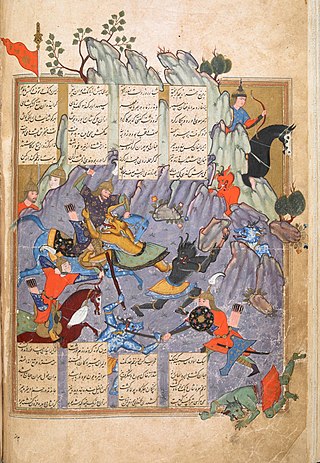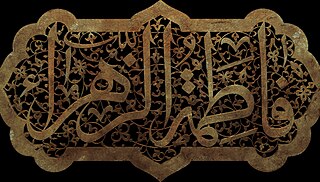
Khwaja Abu Nasr Parsa (died 1461) was a 15th-century Sufi of the Naqshbandi order from the city of Balkh. [1]

Khwaja Abu Nasr Parsa (died 1461) was a 15th-century Sufi of the Naqshbandi order from the city of Balkh. [1]
Abu Nasri Mansur ibn Ali ibn Iraq al-Jaʿdī was a Persian Muslim mathematician and astronomer. He is well known for his work with the spherical sine law.

Abu Nasr Ali ibn Ahmad Asadi Tusi was a Persian poet, linguist and author. He was born at the beginning of the 11th century in Tus, Iran, in the province of Khorasan, and died in the late 1080s in Tabriz. Asadi Tusi is considered an important Persian poet of the Iranian national epics. His best-known work is Garshaspnameh, written in the style of the Shahnameh.

The Samanid Empire also known as the Samanian Empire, Samanid dynasty, Samanid amirate, or simply as the Samanids) was a Persianate Sunni Muslim empire, of Iranian dehqan origin. The empire was centred in Khorasan and Transoxiana; at its greatest extent encompassing Persia and Central Asia, from 819 to 999.
Douglas Morton Dunlop (1909–1987) was a renowned British orientalist and scholar of Islamic and Eurasian history.

Rabia Balkhi, also known as Rabia al-Quzdari was a 10th-century writer who composed poetry in Persian and Arabic. She is the first known female poet to write in Persian.
Parsa as a given name or surname is from Persian origin meaning "devout, pious".

Qatran Tabrizi was a Persian writer, who is considered to have been one of the leading poets in 11th-century Iran. A native of the northwestern region of Azarbaijan, he spent all of his life there as well as in the neighbouring region of Transcaucasia, mainly serving as a court poet under the local dynasties of the Rawadids and Shaddadids.
The shrine of Khwaja Abu Nasr Parsa is located in Balkh, Afghanistan. It was built around 1598 and has an octagonal plan of two stories with axial iwans and corner rooms. Khwaja Abu Nasr Parsa was a spiritual leader of the Naqshbandi order and a theological lecturer in Herat. Although there is no epigraphical evidence identifying the shrine as the site of his tomb, art historians Golombek and Wilber have identified an unmarked tombstone in front of the portal as the Khwaja's grave marker.
The Farighunids were an Iranian dynasty that ruled Guzgan in the late 9th, 10th and early 11th centuries. They were ultimately deposed by the ruler of the Ghaznavid Empire, Sultan Mahmud.

Syed Haji Muhammad Naushah (نوشہ) Ganj Bakhsh Qadiri, a scholar, saint and preacher of Islam in South Asia, was the founder of the Naushahia branch of the Qadiriyya Sufi order. He preached in the tenth and eleventh centuries AH. His adherents call themselves Qadri Naushahi, Naushahi or just Qadri (Qadiri).
Abū Bakr Aḥmad ibn Ḥusayn ibn ʿAlī ibn Mūsā al-Khusrawjirdī al-Bayhaqī, also known as Imām al-Bayhaqī, was a Sunni polymath widely known for being the foremost leading hadith master in his age, leading fuquha of the Shafi'i school, leading authority on the foundation of doctrine, meticulous, a devoted ascetic and known as one of the proponent defenders of the Ash'ari school. Al-Dhahabi said: "Unequalled in his age, unrivalled amongst his peers, and the Ḥāfiẓ of his time."
The Fourteen Infallibles in Twelver Shia Islam are the Islamic prophet Muhammad, his daughter Fatima Zahra, and the Twelve Imams. All are considered to be infallible under the theological concept of Ismah. Accordingly, they have the power to commit sin but by their nature are able to avoid doing so, which is regarded as a miraculous gift from God. The Infallibles are believed to follow only God's desire in their actions because of their supreme righteousness, consciousness, and love for God. They are also regarded as being immune to error in practical matters, in calling people to religion, and in the perception of divine knowledge. Some Twelver Shia believe the Fourteen Infallibles are superior to the rest of creation and to the other major prophets.

Egypt is divided, for the purpose of public administration, according to a three-layer hierarchy and some districts are further subdivided, creating an occasional fourth layer.

Fāṭima bint Muḥammad, commonly known as Fāṭima al-Zahrāʾ, was the daughter of the Islamic prophet Muhammad and his wife Khadija. Fatima's husband was Ali, the fourth of the Rashidun Caliphs and the first Shia Imam. Fatima's sons were Hasan and Husayn, the second and third Shia Imams, respectively.
Nasr, full name Abu al-Juyush Nasr ibn Muhammad, was the fourth Nasrid ruler of the Emirate of Granada from 14 March 1309 until his abdication on 8 February 1314. He was the son of Muhammad II al-Faqih and Shams al-Duha. He ascended the throne after his brother Muhammad III was dethroned in a palace revolution. At the time of his accession, Granada faced a three-front war against Castile, Aragon and the Marinid Sultanate, triggered by his predecessor's foreign policy. He made peace with the Marinids in September 1309, ceding to them the African port of Ceuta, which had already been captured, as well as Algeciras and Ronda in Europe. Granada lost Gibraltar to a Castilian siege in September, but successfully defended Algeciras until it was given to the Marinids, who continued its defense until the siege was abandoned in January 1310. James II of Aragon sued for peace after Granadan defenders defeated the Aragonese siege of Almería in December 1309, withdrawing his forces and leaving the Emirate's territories by January. In the ensuing treaty, Nasr agreed to pay tributes and indemnities to Ferdinand IV of Castile and yield some border towns in exchange for seven years of peace.

The Ministry of Justice is the justice ministry of the government of Egypt. Its headquarters are in Cairo.
Mahmoud Mohamed Mahmoud Abo El-Nasr is an Egyptian engineering professor and politician. He was the minister of education in the interim government of Hazem Al Beblawi and held the position in the interim government of Ibrahim Mahlab.
Ahlam al-Nasr is a Syrian Arabic poet, and is known as "the Poetess of the Islamic State". Her first book of poetry, The Blaze of Truth, was published in 2014 and consists of 107 poems written in monorhyme. She is considered one of the Islamic State's most famous propagandists and gives detailed defenses of terrorist acts.
Abu Nasr may refer to:

Abu Nasr Farahi was a Persian poet and lexicographer from Farah, Sistan, which is now in Afghanistan. Little is known about his life; he is known to have lived during the rule of the Nasrid dynasty and the early period of the Mongol Empire.